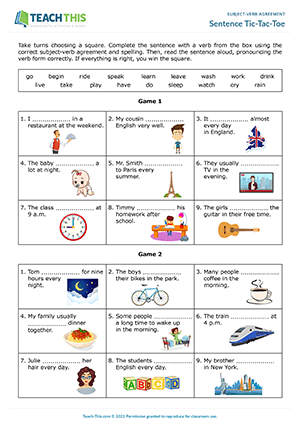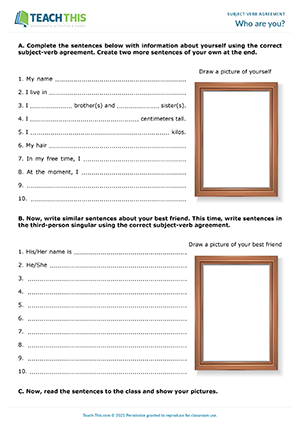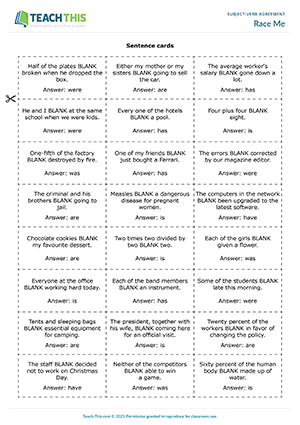

This productive subject-verb agreement worksheet and information gap activity helps students practice subject-verb agreement with the present simple. First, students read an introductory text about subject-verb agreement in the present simple. Students then complete a text about a girl called Francesca with verbs from a box in their correct form. After that, in pairs, students ask and answer questions about Francesca's neighbours and complete a chart with the missing information. Next, students write sentences about the neighbours using the information in the chart and the correct subject-verb agreement. Lastly, students write a sentence to say which neighbour Francesca matches with the most and why, i.e. 'Francesca matches with Audrey because. '



Here is a free subject-verb agreement worksheet to help teach students verb-noun collocations and subject-verb agreement in the present simple. Students begin by matching each verb on their worksheet with three nouns. After the students have matched the verbs and nouns together, they write a present simple sentence for each verb using the given subject pronoun and three nouns.



In this engaging subject-verb agreement game, students play Tic-Tac-Toe by completing present simple sentences with the correct subject-verb agreement and pronouncing verb forms correctly. In pairs, students take turns choosing a square and deciding which verb from the box can be used to complete the sentence. The student then writes the verb in the sentence using the correct subject-verb agreement and spelling and then reads the sentence aloud, pronouncing the verb form correctly. If the student does this successfully, they write their name in the square. If not, the other student can steal the square by correcting the verb, spelling or pronunciation. The game continues until one student gets three squares in a row. When students finish a game, they check their answers with you and then move on to the next game. The first pair to complete both games with the correct verb forms and pronunciation is the winner.



Here is a useful subject-verb agreement worksheet to help students practice present simple and continuous subject-verb agreement in the first and third person. Students begin by completing sentences with information about themselves using the correct subject-verb agreement. Students also create two more sentences of their own at the end. Next, students draw a picture of what they look like. After that, students write similar sentences about their best friend, but this time, they write sentences using the third-person singular. Students also draw a picture of what their best friend looks like.



This insightful subject-verb agreement worksheet is ideal for practicing or reviewing present simple subject-verb agreement. Students start by completing 20 present simple sentences and questions in the first, second and third person with the correct form of the verbs in brackets. After that, students create their own present simple sentences and questions using various subject pronouns and verbs. Finally, in pairs, students read their sentences to each other and check for mistakes.



In this fun subject-verb agreement game, students match subjects, verbs and objects together to make sentences. The first student turns over one subject card, one verb card and one object card in order. If the three cards match to make a grammatically correct sentence, the student reads the sentence aloud, keeps the three cards and has another turn. If the cards don't match, the student turns them back over. It's then the next student's turn to play. Students have to be especially careful to choose the form of the verb that agrees with the subject as each verb has two cards, one with an 's' and one without an 's'. The student with the most cards at the end of the game wins.



Here is a free subject-verb agreement running dictation activity that offers extensive practice of third-person singular subject-verb agreement in the present simple. One student is the reader and the other is the writer. The writers read out the first gapped sentence to their reader, i.e. 'Her name. ' The reader runs to Text A which is about someone's daily routine, reads the text to find the missing information to complete the sentence, remembers it, runs back and tells the writer. The writer then completes the sentence using the correct third-person singular subject-verb agreement. When a pair has completed all 12 sentences, check their answers. If the sentences are correct and use the appropriate subject-verb agreement, students swap roles for Text B. The first pair of students to finish wins.



Here is an interesting subject-verb agreement game for students to play in class. In the game, students play subject-verb agreement draughts using subject and verb counters. A singular or plural subject counter may only take a verb counter or vice versa when there is subject-verb agreement between them. For example, the 'You' counter can take the 'ask' counter but cannot take the 'wants' counter. When there is subject-verb agreement, the student makes a present tense sentence using the two words before taking their opponent's counter. If a student manages to get their counter across the board, the counter becomes a queen. The queen can move around the board freely one square at a time and has subject-verb agreement with all counters. When the students have finished playing, give them a set of game 2 counters and students play again using new subjects and verbs.



In this entertaining subject-verb agreement game, students race to complete sentences with the correct subject-verb agreement. The reader turns over a card and reads the sentence aloud to the two players using the word 'blank' for the missing verb. The players listen and then race to grab the correct verb card (is, are, was, were, have, or has) to complete the sentence with the correct subject-verb agreement. The first player to grab the correct verb card from their set and give it to the reader, saying the verb at the same time wins. The winning student is then given the sentence card and places the verb card back down in front of them. The student with the most sentence cards at the end of the game wins.



In this challenging subject-verb agreement board game, students combine subjects and verbs together to form grammatically correct sentences. Players take turns rolling the dice and moving their counter along the board. When a player lands on a square, they read the subject and two verbs and then try to make a sentence using the correct subject-verb agreement. If the player manages to make a suitable sentence, they stay on the square. If the subject-verb agreement or sentence is incorrect, the player goes back two squares. The first player to reach the finish wins the game.